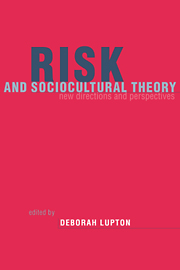Book contents
- Frontmatter
- Contents
- List of contributors
- Introduction: risk and sociocultural theory
- 1 Postmodern reflections on ‘risk’, ‘hazards’ and life choices
- 2 Fear of crime and the media: sociocultural theories of risk
- 3 Risk and the ontology of pregnant embodiment
- 4 Risk anxiety and the social construction of childhood
- 5 Constructing an endangered nation: risk, race and rationality in Australia's native title debate
- 6 Risk, calculable and incalculable
- 7 Ordering risks
- Index
5 - Constructing an endangered nation: risk, race and rationality in Australia's native title debate
Published online by Cambridge University Press: 16 September 2009
- Frontmatter
- Contents
- List of contributors
- Introduction: risk and sociocultural theory
- 1 Postmodern reflections on ‘risk’, ‘hazards’ and life choices
- 2 Fear of crime and the media: sociocultural theories of risk
- 3 Risk and the ontology of pregnant embodiment
- 4 Risk anxiety and the social construction of childhood
- 5 Constructing an endangered nation: risk, race and rationality in Australia's native title debate
- 6 Risk, calculable and incalculable
- 7 Ordering risks
- Index
Summary
A nation at risk?
As Mary Douglas has pointed out, debates about danger and risk are, more importantly, contests over politics and justice (1990: 3, 1994: 44–6, 22–37). Indeed, the debate about native title, perhaps the most important political and cultural debate in contemporary Australia, is laden with images of risk, danger, fear and threat. Since colonization, as I discuss in more detail later in the chapter, Australia has had a doctrine of terra nullius, in which the land was legally considered unoccupied prior to European settlement. Aboriginal land rights were therefore not recognized. The ‘Mabo decision’, passed in 1992 by the Australian High Court, overturned terra nullius, and recognized, in principle, Aboriginal people's prior occupation of the continent, and their common-law rights to land. The result has been the onset of intense political debate and conflict about history, justice, rights and nationhood within Australia. The debate has grown more volatile since the High Court's ‘Wik decision’ in 1996, which was seen by some to extend Aboriginal land rights even further than the Mabo decision.
Newspaper headlines have presented native title as an issue that has brought the nation to the brink of a dangerous abyss, to the point of destruction. Sydney Morning Herald (hereafter SMH) headlines warned of ‘Wik Chaos’ (5 September 1997), of a ‘race crisis’ (18 November 1997) and of the possibility of ‘legal apartheid’ (24 November 1997). Other headlines emphasized Prime Minister John Howard's ‘threat’ of a ‘race election’ and his ‘threat to play race card’ (The Australian, 8–9 November 1997; SMH 8 November and 2 December 1997).
- Type
- Chapter
- Information
- Risk and Sociocultural TheoryNew Directions and Perspectives, pp. 108 - 130Publisher: Cambridge University PressPrint publication year: 1999
- 14
- Cited by



